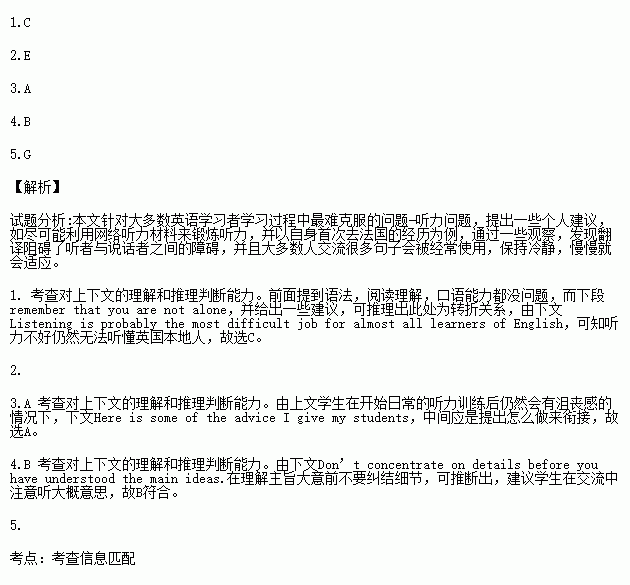题目内容
Does this situation seem familiar to you? Your English is progressing well, the grammar is now familiar, the reading comprehension is no problem, and you are speaking quite fluently._ 1.
First of all, remember that you are not alone. Listening is probably the most difficult job for almost all learners of English as a foreign language. The most important thing is to listen as often as possible.
2. The Internet is really a useful tool for English students. You can download The RealPlayer from RealMedia.com. The RealPlayer allows you to use the Internet like a radio station.
Once you have begun to listen on a regular basis, you might still be frustrated by limited understanding. 3.
Here is some of the advice I give my students:
●Accept the fact that you are not going to understand everything.
●Stay relaxed when you do not understand, and try listening to the material for more times.
● Do not translate everything into your native language.
● 4. Don’t concentrate on details before you have understood the main ideas.
● Listen to something you enjoy.
I remember the problems I had in understanding spoken German when I first went to Germany. In the beginning, when I didn’t understand a word, I insisted on translating it in my mind. This method usually resulted in confusion. 5. Firstly, translating creates a barrier between the listener and the speaker. Secondly, most people repeat themselves constantly. By remaining calm, I noticed that even if I did not pay much attention I could usually understand what the speaker had said.
A. What should you do?
B. Listen for the general idea of the conversation.
C. But you can’t follow a native English speaker at all!
D. But listening is a problem for most of the beginners!
E. So, what you need to do is to find listening resources.
F. However, after several weeks, I got used to the new environment in Germany.
G.Then, after the first six months, I discovered two extremely important facts.
 天天向上一本好卷系列答案
天天向上一本好卷系列答案 小学生10分钟应用题系列答案
小学生10分钟应用题系列答案Summer Hours
June 15 - September 15
Saturday - Thursday: 8:00 am - 8:00 pm
Friday: 9:00 am - 9:00 pm
Regular Hours
January 1 - June 14 and September 16 - December 31
Saturday - Thursday: 8:00 am - 5:00 pm
Friday: 9:00 am - 9:00 pm
Individual Ticket Prices
Venues | Adult(12+) | Senior(60+) | Child(3 - 11) | Group(at least 3 persons) |
Exhibit | Halls | Exhibit | Halls | Exhibit |
Exhibits:
◆ A Bird’s World
This exhibit includes a sample of every bird found in New England. It provides a lot of information about bird behavior, and New England birdwatchers will also find a useful bird “dictionary”. With this, you can learn how to understand the bird language you hear being chirped just outside your window at home.
◆Butterfly Garden
This garden offers a wonderful chance to get close to all kinds of living butterflies from New England and across the world. You can also look inside the “Emergence Box” to see hanging chrysalids(蝶蛹)change into adult butterflies. If you’re lucky, you might see a new butterfly crawl out of its casing.
◆Discovery Center
Designed for children under 8 and their parents, the Discovery Center offers lots of fun, hands - on activities that are designed to help them discover through playing. A perfect area for early learners, this educational environment emphasizes the use of real objects for exploring natural history, physical science, and technology topics.
◆Take a Closer kook
Explore the world around you using sight, hearing, touch and smell. Test yourself to see what you can discover when you pay attention to your senses, and learn how technology extends them.
1.If you visit the exhibits on a Wednesday in August, you can stay there until ________.
A. 3 pm B. 8 pm C. 9 pm D. 5 pm
2.A child at 5 and its parents will have to pay ________.
A. $60.00 B. $80.00
C. $20.00 D. $68.00
3.People, who are interested in the human body, can visit ________.
A. Take a Closer Look B. Butterfly Garden
C. Discovery Center D. A Bird’s World
4.The passage is an advertisement of _________.
A. a sight - seeing park B. a science park
C. a training center D. an art center

